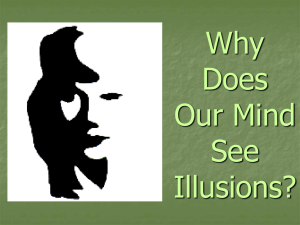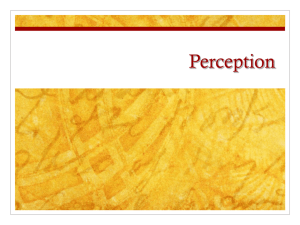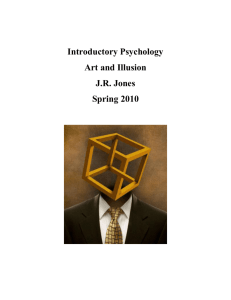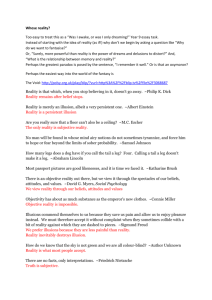Paradoxical form of filled/empty optical illusion
advertisement
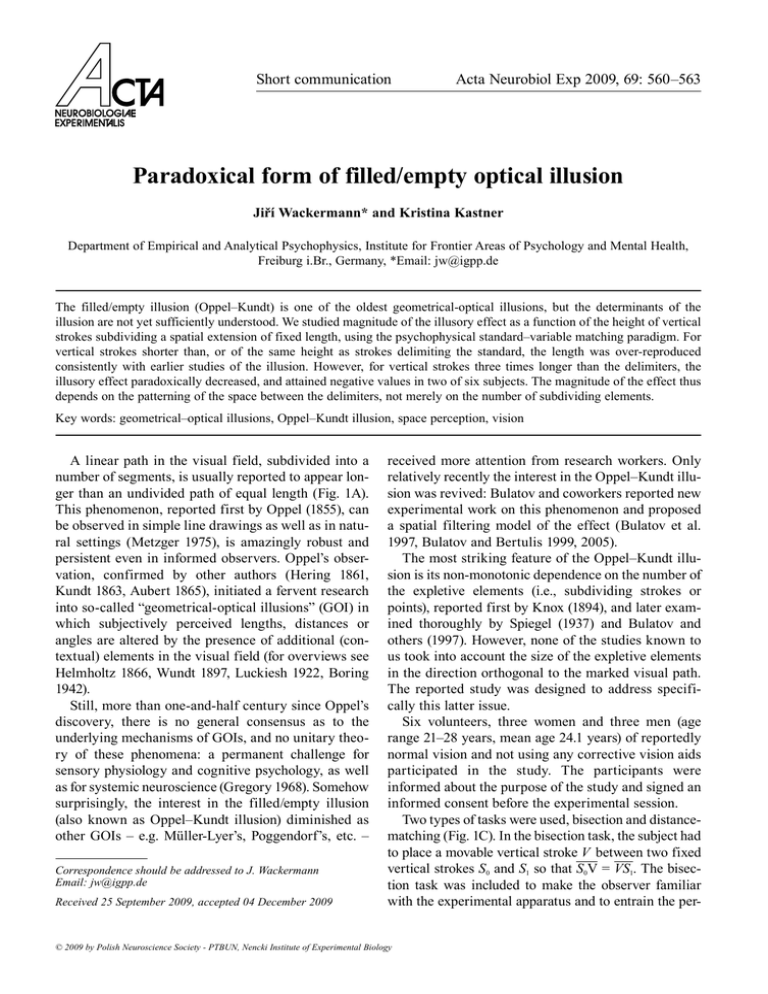
Short communication Acta Neurobiol Exp 2009, 69: 560–563 Paradoxical form of filled/empty optical illusion Jiří Wackermann* and Kristina Kastner Department of Empirical and Analytical Psychophysics, Institute for Frontier Areas of Psychology and Mental Health, Freiburg i.Br., Germany, *Email: jw@igpp.de The filled/empty illusion (Oppel–Kundt) is one of the oldest geometrical-optical illusions, but the determinants of the illusion are not yet sufficiently understood. We studied magnitude of the illusory effect as a function of the height of vertical strokes subdividing a spatial extension of fixed length, using the psychophysical standard–variable matching paradigm. For vertical strokes shorter than, or of the same height as strokes delimiting the standard, the length was over-reproduced consistently with earlier studies of the illusion. However, for vertical strokes three times longer than the delimiters, the illusory effect paradoxically decreased, and attained negative values in two of six subjects. The magnitude of the effect thus depends on the patterning of the space between the delimiters, not merely on the number of subdividing elements. Key words: geometrical–optical illusions, Oppel–Kundt illusion, space perception, vision A linear path in the visual field, subdivided into a number of segments, is usually reported to appear longer than an undivided path of equal length (Fig. 1A). This phenomenon, reported first by Oppel (1855), can be observed in simple line drawings as well as in natural settings (Metzger 1975), is amazingly robust and persistent even in informed observers. Oppel’s observation, confirmed by other authors (Hering 1861, Kundt 1863, Aubert 1865), initiated a fervent research into so-called “geometrical-optical illusions” (GOI) in which subjectively perceived lengths, distances or angles are altered by the presence of additional (contextual) elements in the visual field (for overviews see Helmholtz 1866, Wundt 1897, Luckiesh 1922, Boring 1942). Still, more than one-and-half century since Oppel’s discovery, there is no general consensus as to the underlying mechanisms of GOIs, and no unitary theory of these phenomena: a permanent challenge for sensory physiology and cognitive psychology, as well as for systemic neuroscience (Gregory 1968). Somehow surprisingly, the interest in the filled/empty illusion (also known as Oppel–Kundt illusion) diminished as other GOIs – e.g. Müller-Lyer’s, Poggendorf’s, etc. – Correspondence should be addressed to J. Wackermann Email: jw@igpp.de Received 25 September 2009, accepted 04 December 2009 received more attention from research workers. Only relatively recently the interest in the Oppel–Kundt illusion was revived: Bulatov and coworkers reported new experimental work on this phenomenon and proposed a spatial filtering model of the effect (Bulatov et al. 1997, Bulatov and Bertulis 1999, 2005). The most striking feature of the Oppel–Kundt illusion is its non-monotonic dependence on the number of the expletive elements (i.e., subdividing strokes or points), reported first by Knox (1894), and later examined thoroughly by Spiegel (1937) and Bulatov and others (1997). However, none of the studies known to us took into account the size of the expletive elements in the direction orthogonal to the marked visual path. The reported study was designed to address specifically this latter issue. Six volunteers, three women and three men (age range 21–28 years, mean age 24.1 years) of reportedly normal vision and not using any corrective vision aids participated in the study. The participants were informed about the purpose of the study and signed an informed consent before the experimental session. Two types of tasks were used, bisection and distancematching (Fig. 1C). In the bisection task, the subject had to place a movable vertical stroke V between two fixed vertical strokes S0 and S1 so that S0V = VS1. The bisection task was included to make the observer familiar with the experimental apparatus and to entrain the per- © 2009 by Polish Neuroscience Society - PTBUN, Nencki Institute of Experimental Biology Paradoxical optical illusion 561 Fig. 1. (A) Oppel–Kundt illusion: Distance QR appears larger than distance PQ, although the two extents are objectively equal. (B) Different types of Oppel–Kundt figure (OKF) used in the distance-matching task. (C) Schematic representation of the two tasks used in the reported study. Grey arrows indicate the movable element. (D) Variant stimuli used in the bisection task (left) and in the distancematching task (right: OKF type 1 shown for example). (E) The observer watching the monitor (1) with her head fixated by a chin/forehead support (2). ception of equal distances. In the distance-matching task, the subject had to reproduce a distance delimited by S0 and S1, adjusting the movable element V so that VS0 = S0 S1. This task was used with four forms of the Oppel–Kundt figure (OKF) described below. The delimiters S 0 and S1 were constantly vertical lines of 15 pixels height (seen under visual angle 0.25° from the observer’s place). In the bisection task, the distance S 0 S1 was 336 pixels (visual angle 5.6°), and the space between the strokes was empty. In the distance matching task, the distance S 0 S1 was 168 pixels (visual angle 2.8°), and the space between the strokes was either empty or filled with 20 equispaced strokes of varied height, 5, 15, or 45 pixels (Fig. 1B). These four forms are hereafter referred to as OKF type 0, 1, 2, and 3, respectively. Figure type 0 is a limiting case of the OKF, which was not expected to produce any illusory effect; in fact, the bisection task and the distance-matching task with OKF type 0 are equivalent. Two stimulus variants were used for the bisection task, distinguished by the initial position of the movable element V, in the left or the right half of the figure (Fig. 1C), hereafter identified as LBI and RBI, respectively. In the distance-matching task, the movable element V could be placed on the left (L) or the right (R) hand of the standard, S0 S1, whereas the initial position of the movable element was chosen either near to (N) or far from (F) the proximal fixed stroke S0. Factorial combination of these attributes yielded 2 × 2 = 4 variants of the stimulus for each figure type, hereafter identified as LNh, LFh, RNh, RFh (where h = 0,...,3 encodes the height of the filling strokes; see Fig. 1B). Visual stimuli for the distance-matching and bisection tasks were displayed on a 19” TFT monitor, connected to an iBook G4 running the X11 graphics application on the Mac OS X operating system. Okfdisp, a program developed specifically for the purpose of the reported study, was used to present the stimuli and to register the subject’s responses. Drawings were neutral black on a bright white background (luminosity ratio ≈1:100). The monitor was covered with a grey cardboard mask of dimensions 50 × 34 cm, in which a rectangular opening of size 36 × 20 cm was cut, to hide the window frame and its control elements (which otherwise could serve as auxiliary position cues) from the subject’s sight. Subjects were watching binocularly the monitor at a fixed distance of 130 centimeters (Fig. 1E1). The distance was chosen so that at the given screen resolution, 1024 × 768 pixels, the angular size of 1 pixel was exactly 1 arc minute. A chin/forehead support was used to assure the subject’s comfort while keeping a constant eyes–monitor distance (Fig. 1E2). The subjects were operating with their dominant hand a pointing device (‘mouse’) connected via USB to the control computer. The movable element in the visual stimulus could be directly dragged to the destination position, or finely positioned at one-pixel steps, using a wheel control on the pointing device. After the movable element had been positioned, the subject confirmed the response by pressing simultaneously both buttons on the pointing device. Each experimental session consisted of five blocks. The bisection task was given in the first block as a “warm-up” task. The next four blocks comprised the distance-matching task with different forms of the OKF. 562 J. Wackermann and K. Kastner Fig. 2. Deviations from the geometrically correct response (dotted baseline) in the distance-matching task. Abscissae: labels of four different types of OKFs as shown in Fig. 1B. Ordinates: relative deviation in percents (left); absolute deviation in angular units (right). Displayed are individual means (small circles, dashed lines) for all six subjects, and grand means over the subjects (large circles, solid line). The empty form of the OKF (type 0) was always used in block no. 2; the three other types were used in permuted order in blocks no. 3 to no. 5. Different variants of the stimuli were presented in a pseudo-random order within a block. Six trials were run with each variant, resulting in 2 × 6 = 12 bisection trials and 4 × 6 = 24 distancematching trials for each of the four OKF types. The entire session thus comprised 12 + 4 × 24 = 108 trials for each observer. Short breaks between blocks were allowed for the observer’s refreshment. In the following s := S0 S1 denotes the standard distance (168 pixels) and v := VS1 the variable. The absolute deviation v − s is known to be a linear function of s (Bulatov et al. 1997); therefore the relative deviation from the geometrically correct response, (1) was used as the effect measure. For each subject, data were sorted by stimulus conditions (OKF type 0–3) and the r values were averaged separately for each of the four data subsets (24 trials). Since the four variants of the stimulus, LN, LF, RN, RF were applied with equal frequencies, possible individual effects such as matching side-dependent or initial position-dependent response biases average out in the final results. t-statistics were evaluated to test deviations of the individual means from zero. In addition, grand means across all six observers were calculated for descriptive purposes. The results are summarized in Table I and shown in Fig. 2. For markers separated by empty space (OKF type 0), the reproduced distances did not deviate from, or were slightly shorter than, the standard distance. For the space between markers filled with vertical strokes shorter or of the same length as the markers (OKFs type 1 and 2, respectively), the standard distance was significantly over-reproduced, as expected; shorter strokes consistently produced smaller effect in all six observers. However, with the OKF type 3 (long vertical lines) the effect paradoxically decreased and in two observers dropped significantly to negative values; the grand mean effect for the OKF type 3, averaged over all six subjects, was almost exactly zero. The non-linear, non-monotonic dependence of the Oppel–Kundt illusion magnitude on the number of expletive elements was demonstrated by early studies (Knox 1894, Spiegel 1937), and confirmed by later research (Bulatov et al. 1997). This fact per se invalidates early naïve explanations of the illusion in terms of the eye’s geometry (the “secant theory”: Hering 1861, Kundt 1863). Our results reveal non-monotonicity of the effect as a function of the extent of expletive elements in a direction orthogonal to the perceived extension, while their number was kept constant. This finding rules out those models, which take into account only the numerosity of the expletive elements, and thus helps to constrain the variety of explanatory approaches. In summary, the assertion that “a filled space seems larger than an empty space” needs a further qualification. The effect obviously depends on how the spatial interval is filled. Depending on the form of the stimulus, a filled spatial extension may appear to the subject as smaller than the same extension unfilled – a fact to be taken into account in further modeling and explanations of the illusory effect. Finally, we should note that the filled/empty illusion is not limited to perception of spatial extensions: a similar illusion is known in perception of temporal durations (Grimm 1934, Buffardi 1971, Thomas and Brown 1974). The analogy between the spatial and the temporal domain (Fraisse 1963) suggests that a fundamental principle of perception is at work here. The ultimate question then is: how is the subjective metric of a perceptual field (co)determined by its perceived content? Interestingly, this problem parallels the notion of the objective metric of the physical space as being determined by the world’s material content (Weyl 1922). Paradoxical optical illusion 563 Table I Shown are individual mean relative deviations r from geometrically correct response (per cents, see Eq. 1), their standard deviations, and the corresponding t-statistics (23 d.f.) for observers nos. 1–6. The bottom line shows grand means (GM) across all six subjects and numbers of significantly positive/negative (+/−) individual means. OKF type Obs. no. Mean 0 SD t Mean 1 SD t Mean 2 SD t Mean 3 SD t 1 2 3 4 5 6 0.82 1.07 1.84 −5.41 −1.76 −1.81 3.56 5.37 4.30 8.20 3.99 3.30 1.13 0.97 2.09 −3.23* −2.16 −2.69* 2.88 11.83 12.13 7.07 11.43 9.87 4.17 5.03 3.56 4.91 5.71 5.88 3.38* 11.52* 16.70* 7.05* 9.81* 8.22* 9.10 18.68 18.13 13.94 13.14 16.02 5.62 7.86 5.75 7.22 5.29 4.23 7.94* 11.64* 15.43* 9.46* 12.16* 18.55* −4.69 1.74 5.90 0.74 −6.30 4.04 4.35 5.58 6.43 6.27 4.90 4.57 −5.28* 1.52 4.50* 0.58 −6.03* 4.33* GM +/− GM +/− GM +/− GM +/− −0.88 0/2 9.20 6/0 14.84 6/0 0.24 2/2 1−6 (*) Significant deviations (P<0.02, two-tailed) from zero We thank Peter Pütz and Matthias Gäßler for technical assistance. We are grateful to Robert Bishop and Werner Ehm for reading and commenting earlier drafts of the present communication. We thank all participants for their time and patience. Aubert H (1865) Physiology of Retina (in German). Morgenstern, Breslau. Boring EG (1942) Sensation and Perception in the History of Experimental Psychology. Appleton-Century-Crofts, New York, NY. Buffardi L (1971) Factors affecting the filled-duration illusion in the auditory, tactual, and visual modalities. Perc Psychophys 10: 292–294. Bulatov A, Bertulis A, Mickienė L (1997) Geometrical illusions: study and modelling. Biol Cybern 77: 395– 406. Bulatov A, Bertulis A (1999) Distortions of length perception. Biol Cybern 90: 185–193. Bulatov A, Bertulis A (2005) Superimposition of illusory patterns with contrast variations. Acta Neurobiol Exp (Wars) 65: 51–60. Fraisse P (1963) The Psychology of Time. Harper & Row, New York, NY. Gregory RL (1968) Perceptual illusions and brain models. Proc R Soc B171: 179–196. Grimm K (1934) Influence of temporal form on perception of temporal intervals (in German). Z Psychol 132: 104–132. Helmholtz H (1866) Handbook of Physiological Optics (in German). Vol. 3. Barth, Leipzig. Hering E (1861) Contributions to physiology (in German). Vol. 1. Engelmann, Leipzig. Knox HW (1894) On the quantitative determinants of an optical illusion. Am J Psychol 6: 413–421. Kundt A (1863) Investigations of visual measure and optical illusions (in German). Ann Phys Chem 196: 118–158. Luckiesh M (1922) Visual Illusions, Their Causes, Characteristics and Applications. Van Nostrand, New York, NY. Metzger W (1975) Laws of Seeing (in German). 3rd ed. Kramer, Frankurt. Oppel JJ (1855) On geometrical-optical illusions (in German). Jahresber phys Ver Frankfurt 1854–1855: 37–47. Spiegel HG (1937) On the influence of the intermediate field on visually assessed distances (in German). Psychol Forsch 21: 327–383. Thomas EAC, Brown I (1974) Time perception and the filled duration illusion. Perc Psychophys 16: 449–458. Weyl H (1922) Space – Time – Matter. Dover, New York, NY. Wundt W (1897) The geometrical-optical illusions (in German). Abh Königl Sächs Gesellsch Wiss 42: 55–178.
